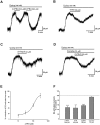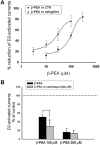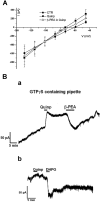Trace amines depress D(2)-autoreceptor-mediated responses on midbrain dopaminergic cells
- PMID: 20590640
- PMCID: PMC2938821
- DOI: 10.1111/j.1476-5381.2010.00792.x
Trace amines depress D(2)-autoreceptor-mediated responses on midbrain dopaminergic cells
Abstract
Background and purpose: Although trace amines (TAs) are historically considered 'false neurotransmitters' on the basis of their ability to induce catecholamine release, there is evidence that they directly affect neuronal activity via TA receptors, ligand-gated receptor channels and/or sigma receptors. Here, we have investigated the effects of two TAs, tyramine (TYR) and beta-phenylethylamine (beta-PEA), on electrophysiological responses of substantia nigra pars compacta (SNpc) dopaminergic cells to the D(2) receptor agonist, quinpirole.
Experimental approach: Electrophysiological recordings of D(2) receptor-activated G-protein-gated inward rectifier K(+) channel (GIRK) currents were performed on dopaminergic cells from midbrain slices of mice and on Xenopus oocytes expressing D(2) receptors and GIRK channels.
Key results: TYR and beta-PEA reversibly reduced D(2) receptor-activated GIRK currents in a concentration-dependent manner on SNpc neurones. The inhibitory effect of TAs was still present in transgenic mice with genetically deleted TA(1) receptors and they could not be reproduced by the selective TA(1) agonist, o-phenyl-3-iodotyramine (O-PIT). Pretreatment with antagonists of sigma1 and sigma2 receptors did not block TA-induced effects. In GTPgammaS-loaded neurones, the irreversibly-activated GIRK-current was still reversibly reduced by beta-PEA. Moreover, beta-PEA did not affect basal or dopamine-evoked GIRK-currents in Xenopus oocytes.
Conclusions and implications: TAs reduced dopamine-induced responses on SNpc neurones by acting at sites different from TA(1), sigma-receptors, D(2) receptors or GIRK channels. Although their precise mechanism of action remains to be identified, TAs, by antagonizing the inhibitory effects of dopamine, may render dopaminergic neurones less sensitive to autoreceptor feedback inhibition and hence enhance their sensitivity to stimulation.
Figures





Similar articles
-
D3 dopamine autoreceptors do not activate G-protein-gated inwardly rectifying potassium channel currents in substantia nigra dopamine neurons.J Neurosci. 2003 Jul 2;23(13):5693-7. doi: 10.1523/JNEUROSCI.23-13-05693.2003. J Neurosci. 2003. PMID: 12843272 Free PMC article.
-
Tipepidine activates VTA dopamine neuron via inhibiting dopamine D₂ receptor-mediated inward rectifying K⁺ current.Neuroscience. 2013 Nov 12;252:24-34. doi: 10.1016/j.neuroscience.2013.07.044. Epub 2013 Jul 26. Neuroscience. 2013. PMID: 23896570
-
Cav1.3 channels control D2-autoreceptor responses via NCS-1 in substantia nigra dopamine neurons.Brain. 2014 Aug;137(Pt 8):2287-302. doi: 10.1093/brain/awu131. Epub 2014 Jun 16. Brain. 2014. PMID: 24934288 Free PMC article.
-
Trace amine-associated receptor 1-Family archetype or iconoclast?Pharmacol Ther. 2007 Dec;116(3):355-90. doi: 10.1016/j.pharmthera.2007.06.007. Epub 2007 Jul 17. Pharmacol Ther. 2007. PMID: 17888514 Free PMC article. Review.
-
2-Phenethylamines in Medicinal Chemistry: A Review.Molecules. 2023 Jan 14;28(2):855. doi: 10.3390/molecules28020855. Molecules. 2023. PMID: 36677913 Free PMC article. Review.
Cited by
-
Trace amine-associated receptor 1: A promising target for the treatment of psychostimulant addiction.Eur J Pharmacol. 2015 Aug 15;761:345-52. doi: 10.1016/j.ejphar.2015.06.019. Epub 2015 Jun 16. Eur J Pharmacol. 2015. PMID: 26092759 Free PMC article. Review.
-
The role of β-adrenergic blockers in Parkinson's disease: possible genetic and cell-signaling mechanisms.Am J Alzheimers Dis Other Demen. 2013 Jun;28(4):306-17. doi: 10.1177/1533317513488919. Epub 2013 May 21. Am J Alzheimers Dis Other Demen. 2013. PMID: 23695225 Free PMC article. Review.
-
Dopamine Evokes a Trace Amine Receptor-dependent Inward Current that is Regulated by AMP Kinase in Substantia Nigra Dopamine Neurons.Neuroscience. 2020 Feb 10;427:77-91. doi: 10.1016/j.neuroscience.2019.11.044. Epub 2019 Dec 26. Neuroscience. 2020. PMID: 31883822 Free PMC article.
-
TAAR1 activation modulates monoaminergic neurotransmission, preventing hyperdopaminergic and hypoglutamatergic activity.Proc Natl Acad Sci U S A. 2011 May 17;108(20):8485-90. doi: 10.1073/pnas.1103029108. Epub 2011 Apr 27. Proc Natl Acad Sci U S A. 2011. PMID: 21525407 Free PMC article.
-
Trace amine-associated receptor 1 (TAAR1): an emerging therapeutic target for neurodegenerative, neurodevelopmental, and neurotraumatic disorders.Naunyn Schmiedebergs Arch Pharmacol. 2025 May;398(5):5057-5075. doi: 10.1007/s00210-024-03757-6. Epub 2024 Dec 30. Naunyn Schmiedebergs Arch Pharmacol. 2025. PMID: 39738834 Review.
References
-
- Bailey BA, Philips SR, Boulton AA. In vivo release of endogenous dopamine, 5-hydroxytryptamine and some of their metabolites from rat caudate nucleus by phenylethylamine. Neurochem Res. 1987;12:173–178. - PubMed
-
- Barroso N, Rodriguez M. Action of β-phenylethylamine and related amines on nigrostriatal dopamine neurotransmission. Eur J Pharmacol. 1996;297:195–203. - PubMed
-
- Bergman J, Yasar S, Winger G. Psychomotor stimulant effects of beta-phenylethylamine in monkeys treated with MAO-B inhibitors. Psychopharmacology (Berl) 2001;159:21–30. - PubMed
-
- Berry MD. Mammalian central nervous system trace amines. Pharmacological amphetamines, physiological neuromodulators. J Neurochem. 2004;90:257–271. - PubMed
Publication types
MeSH terms
Substances
LinkOut - more resources
Full Text Sources
Molecular Biology Databases
Miscellaneous

